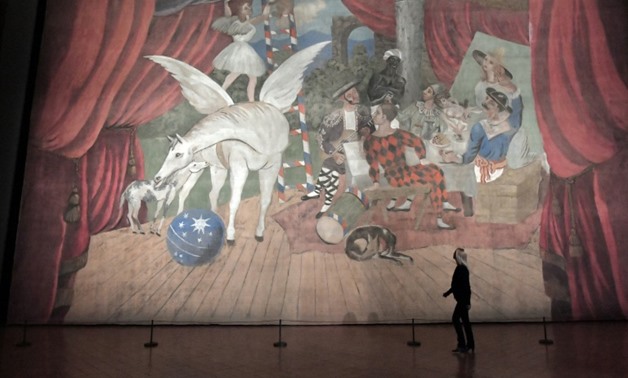
"Parade", Pablo Picasso's monumental stage curtain, is the artist's largest work-AFP / TIZIANA FABI
22 September 2017: In the frosty first months of 1917, Spanish master Pablo Picasso travelled to Italy in search of inspiration for the sets he was designing for the "Parade" ballet.
One hundred years on, a new exhibition in Rome celebrates that journey with 100 paintings, drawings, watercolours, sketches and stage costumes looking at how Italy and the Ballets Russes theatrical troupe inspired the artist.
"Picasso between Cubism and Neo-Classicism: 1915-1925" opens on Friday at the Quirinal Stables, but the highlight -- an enormous work titled "Parade" -- is going on show at the nearby Palazzo Barberini.
It was one of the few spaces in the Italian capital able to accommodate the monumental stage curtain with its winged horse and street performers, which measures 16.5 metres by 10.5 metres (52.5 feet by 33.8 feet).
"It is the biggest work painted by Picasso but it also marks the end of his Cubist period and return to the figurative," Palazzo Barberini director Flaminia Gennari Santori told AFP.
"The trip to Italy was very important for Picasso, who was very interested in artists like Bernini, in Baroque sculpture and painting," she added.
Picasso, who was based in Paris, arrived in Italy in February 1917 to meet Serge de Diaghilev, the founder of the Ballets Russes, for a collaboration which would revive his spirits.
"The world was at war, and he, a Spanish man on French soil, had seen many of his fellow travellers go to the front. He was sad and had little work," said curator Olivier Berggruen.
The two months of his Grand Tour around Italy would prove fateful for the 36-year-old. Shortly after his arrival in Rome he met Olga Khokhlova, a ballet dancer who would become his wife and principal muse.
"When he was not with Olga, the artist liked to immerse himself in the lively atmosphere on the streets of Rome or Naples, attracted by popular shows but also by classic monumental sculpture," Berggruen said.
And the Vesuvius volcano in southern Italy created such an impression on the artist he included it in "Parade".
Comments
Leave a Comment